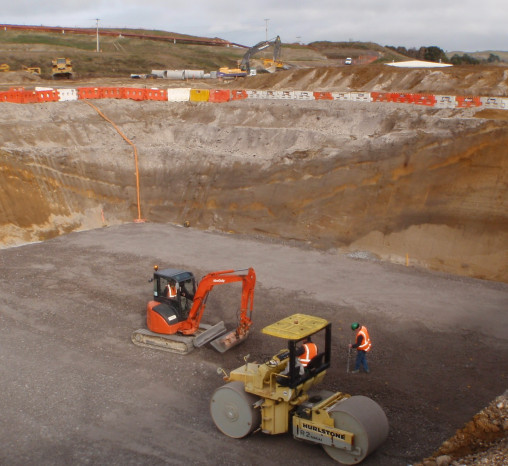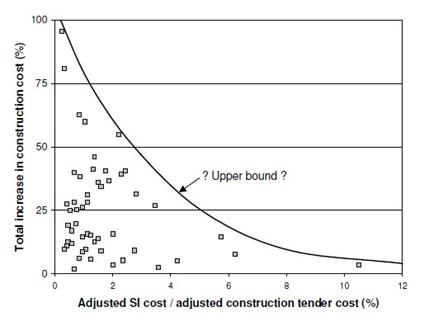Practice Advisory 17: Well-planned ground investigations can save costs

The need for early site investigation is a key element in controlling costs of a project. This advisory describes the aims of site investigation, investment considerations and the site investigation strategy - including extent, depth and inherent uncertainties.
This information was confirmed as current in July 2018.
This Practice Advisory is issued as guidance information in accordance with section 175 of the Building Act 2004 and, if used, does not relieve any person of the obligation to consider any matter to which the information relates according to the circumstances of the particular case. This document is not a compliance document in terms of the Act and not a substitute for professional advice.
Background
The Canterbury Earthquakes Royal Commission recommended that “A thorough and detailed geotechnical investigation of each building site, leading to development of a full site model, should be recognised as a key requirement for achieving good foundation performance”. Evidence from the Canterbury earthquakes indicated that inadequate or inappropriate site investigations contributed to poor building performance. With increasing building activity in New Zealand, it is important to learn from this and encourage the practice of adequate and appropriate site investigations.

Objective of site investigations
A ground investigation serves two primary purposes, by:
- providing data for analysis and design
- reducing uncertainty about ground conditions, thereby reducing the risk of construction cost variations.
The amount, location and method of ground investigation should be selected with both these aims in mind. The objective of a site investigation needs to be aligned with the project’s requirements and the risks associated with unforeseen conditions or poor performance. The ground on which a building is built can be quite variable (refer to Figure 1). Ground conditions can vary with time, e.g. following earthquake, consolidation, weathering, deposition or erosion. This can pose real challenges in the design of a building and its foundations to withstand the potential impact of both existing conditions and the effects of natural hazards (such as earthquakes). Therefore, the objective of a site investigation is to gain a good understanding of:
- the geological makeup and history of the site (including the various subsurface soil layers and their properties, and groundwater conditions)
- the expected future behaviour of the site under a range of conditions, including seismic actions.
The understanding of site soil conditions is an essential input into robust foundation solutions.
| Objectives |
|
Do
|

Investment considerations
There can be tension between the desire of the geotechnical professional to perform technically optimised foundation design with more ground data through site investigations and the desire of the building owner or developer to minimise cost, particularly at the early stages of project development.
However, there is strong evidence of a direct correlation between a ‘lowest cost’ approach to ground investigations and very expensive project cost over-runs (Figure 2). An appropriately-scoped site investigation is usually a modest investment compared to the potential consequences of unsatisfactory ground performance. Appropriate site investigation can lead to construction cost savings. Conversely, under-investment in site investigations may lead to cost overruns and delays to projects at both the design and construction stages by failing to adequately identify ground issues. It can also result in post-development building performance issues.
| Investment considerations |
|
Do
|
|
Do not
|
There is international evidence that a comprehensive site investigation can pay for itself many times over in reduced construction cost overruns.

Figure 2: Impact of site investigation (SI) expenditure on UK highways contracts. From Mott MacDonald and Soil Mechanics, (1994).
When deciding on the scope and expenditure of a geotechnical site investigation, the knowledge of the site, the project objectives, complexity and risks all need to be considered.
Site investigation strategy
A site should not be considered in isolation, but in context with its surroundings, hazards and the landscapes of the area.
Depending on the particular characteristics of a project, it could involve, as a minimum, a non-intrusive desk study and a site walkover to develop a high-level understanding of the site. The desk study usually includes the collection of information from existing geological and hazard maps, published databases or documents, utility records, anecdotal evidence and aerial photographs.
This can then be followed by some or all of the following physical investigation works such as:
- trial pits
- boreholes
- penetration tests
- geophysical tests
- laboratory tests.
The investigation results are typically collated into a report. This may include interpretation of the data to inform the design process.
The site investigation strategy in areas of identified high ground-related risks (contaminated land, liquefiable soils, etc) should be closely communicated with the relevant authorities so that the objectives of investigations (for the project) meet or exceed legislative and consenting requirements.
Ground investigation is a risk assessment and management process, and, as such, is sometimes undertaken in an iterative manner. Risks are identified, investigated, and the outcome of these investigations determines the next steps. It should also be noted that additional investigation might be needed during design or construction as new risks are identified.
| Strategy |
|
Do
|
|
Do not
|
Extent and depth of site investigations
The geotechnical professional should determine the extent of a site investigation programme.
More information on site investigation of soils can be found in the MBIE-NZGS Guidance: Module 2 ‘Geotechnical investigation for earthquake engineering’ of the ‘Earthquake Geotechnical Engineering Practice’ series document.
Module 2: Geotechnical investigations for earthquake engineering
NZ Ground Investigation Specification, a guide on procurement of site investigation, developed by Auckland Council, MBIE and New Zealand Geotechnical Society (NZGS) is also available on the NZGS website.
| Extent and depth |
|
Do
|
Uncertainties in site investigations
It should be recognised that a site investigation programme samples at discrete points, and an interpretative model is then inferred from this data. Natural ground formation processes can lead to marked changes in subsurface location of soil strata over short distances. Therefore the actual ground stratigraphy may be different from that anticipated. It is recommended that the geotechnical professional be involved throughout the construction phase to check that design assumptions made are compatible with what is encountered on site during excavations
Given the above-mentioned uncertainties and limitations, it is recommended that all site investigations should be carried out under the supervision of an appropriately qualified geotechnical professional.
Site investigations where there are complex subsoil and ground water conditions, such as:
- compressive soils
- expansive soils
- liquefaction-prone soils
- organic soils
- unstable soils
should be carried out by specialist geotechnical professionals with appropriate training and experience. Projects involving major bridges, dams, steep slopes, high retaining walls, natural hazards and multi-storey buildings with deep basements would likely require highly specialised geotechnical professionals.
| Limitations |
|
Do
|
References
- AGS guidelines for good practice in site investigation: version 2 — Association of Geotechnical & Geoenvironmental Specialists (2006).
- Interim report — Canterbury Earthquakes Royal Commission (2011).
- Final report, roles and responsibilities (vol 7) — Canterbury Earthquakes Royal Commission (2012).
- Final report, summary and recommendations in volumes 1 – 3, seismicity, soils and the seismic design of buildings (vol. 1) — Canterbury Earthquakes Royal Commission (2012).
- Inadequate site investigation — Institution of Civil Engineers (1991). ISBN: 0 7277 1645 X British Library.
- Study of efficiency of site investigation practices. Transport Research Laboratory Wokingham. TRRL Project Report 60 — Mott MacDonald and Soil Mechanics (1994).
- Guidance on the assessment, repair and rebuild of earthquake-affected industrial buildings in Canterbury — Ministry of Business, Innovation & Employment and New Zealand Geotechnical Society (2014)
- Effective site investigation — Site Investigation Steering Group (2013).
- Geotechnical Site Investigations (AS 1726), Standards Australia, North Sydney — Standards Association of Australia (1993).
- Module 2: Geotechnical investigations for earthquake engineering — Ministry of Business, Innovation & Employment and New Zealand Geotechnical Society (2017)
- NZ Ground Investigation Specification — Vols 0 — 3, Auckland Council (2017)